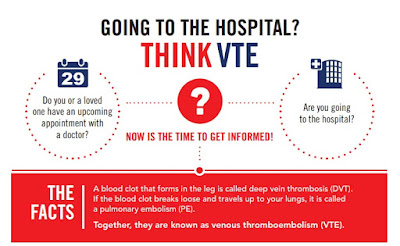 |
| Search or Use #ThinkVTE on Social Media. |
- Stroke
- Heart attack
- Hypertension
- Cancer, particularly breast and prostate forms
As I move into the second half of my life, I am working to control risk factors.
I'm also learning about symptoms so that I can seek medical attention at the sign of any of the above diseases.
I'm also learning about symptoms so that I can seek medical attention at the sign of any of the above diseases.
[Note: Please see a licensed medical professional if you have any concerns about your health. This post does not give medical advice; its aim is to raise awareness only.]
However, I just recently learned about a lesser-known, yet prevalent health problem:
VTE is a condition where clots form in the vein, usually in the leg (DVT) and increase the possibility of traveling to the lungs, causing a pulmonary embolism (PE), which can be fatal.
In preparation for participating in World Thrombosis Day 2015 as an influencer, I received training from Dr. Gary Raskob, a world expert on the topic, included this statement in his presentation materials:
"Worldwide, 1 in 4 people die from causes related to thrombosis; it is a common underlying cause of the world's three leading cardiovascular killers:
- Heart attack
- Stroke (ischemic kind not hemorrhagic kind)
- Venous thromboembolism"
In the following 6 minute video, Dr. Raskob delivers a brief-yet-comprehensive portrait of VTE, created for last year's inaugural World Thrombosis Day, which was October 13, 2014.
Watching this may help save a life.
To watch more videos on the topic, see 2015's WTD set of videos.
There are a number of risk factors: hospital admission, surgery, age (increases by 60+ years old, but can happen at ANY age), family history, personal history, reduced mobility, cancer/chemotherapy, estrogen-based medications (e.g., oral contraceptives or hormone replacement therapy), pregnancy or recent birth, obesity, and smoking.
Read these personal stories to better understand how the above risk factors affect a broad demographic of individuals.
I sit a lot.
Because I teach classes online, read voraciously, sit to watch films about aging, and maintain a blog, I am concerned about the health risk of extended sitting.
The Mayo Clinic explains why sitting increases the risk of blood clots in the legs:
"When your leg remains still for many hours, your calf muscles don't contract, which normally helps blood circulate."
"Blood clots can form in the calves of your legs if your calf muscles aren't moving for long periods."
Does your job require you to sit for long periods in cramped quarters?
Do you travel frequently by plane?
Do you have a long commute by car or train?
Do you have health problems that limit your mobility?
I need to get up more frequently and move around.
Hospitalization and Surgery are also risk factors.
Luckily, this hasn't been an issue for me, but it's prevalent enough, that I wanted to include infographics about these risks for readers before closing.
Click on the images to enlarge them.
 |
| Click on Image to Enlarge |
 |
| Click on Image to Enlarge |
The organizers of World Thrombosis Day 2015 have created a rich set of webpages in an effort to help with prevention and treatment. This blog post just conveys a small portion of their materials.
I encourage you to take advantage of the well-researched and free information provided.
And please share broadly with friends and family through email and social media (Facebook, Instagram, Twitter, Pinterest, etc.).
Related
Know the Signs of Stroke
Subtle and Atypical Signs of Heart Attack
Alz Awareness Month


This is something that concerns me, too. I try to remember to get up a lot during the day to walk around and definitely on long plane trips.
ReplyDeleteI had very little awareness about this until invited to participate. I was glad to do all the reading about risks and symptoms. I hope you get to fly someplace interesting soon. I will follow your example of moving more while flying. Good idea!
DeleteGreat post. My fit husband had a DVT at age 52! We found out later he had a blog clot in his leg that most likely was always there and can be a genetic trait. Like a stroke or heart attack, action needs to be taken fast.He "threw" a clot and it went to his lung, a pulmonary embolism .The ER doctor told us we were lucky we lived close to the hospital, it was a Sunday evening and they weren't busy. Now he just takes blood thinner and is fine. I do beat him to get up with me every 60-90 minutes when we travel.
ReplyDeleteI am so happy to read your husband got an accurate diagnosis and timely treatment. Scary! Whew! All my best to you both for good health.
DeleteIt is that getting up every 90 minutes or so that gets me. I get lost in a project and time just goes. I need to work on that. Seriously. This is such great information Karen and needs to get out there. Know the signs. Best advice ever! Thank you!
ReplyDeleteI know! I'm hesitant to set a timer, because I enjoy being in "the zone," but I don't think I'd enjoy a clot. I guess I'll start setting an alarm on my phone for hour intervals or something.
Delete